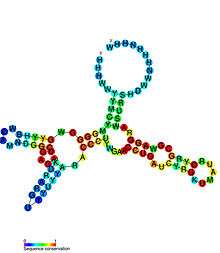TPP riboswitch
| TPP riboswitch (THI element) | |
|---|---|
 Predicted secondary structure and sequence conservation of TPP | |
| Identifiers | |
| Symbol | TPP |
| Alt. Symbols | THI |
| Rfam | RF00059 |
| Other data | |
| RNA type | Cis-reg; riboswitch |
| Domain(s) | Eukaryota; Bacteria; Archaea |
| GO | 0030976 |
| SO | 0000035 |

The TPP riboswitch, also known as the THI element and Thi-box riboswitch, is a highly conserved RNA secondary structure. It serves as a riboswitch[2][3] that binds directly to thiamine pyrophosphate (TPP) to regulate gene expression through a variety of mechanisms in archaea, bacteria and eukaryotes.[4][5][6] TPP is the active form of thiamine (vitamin B1), an essential coenzyme synthesised by coupling of pyrimidine and thiazole moieties in bacteria. The THI element is an extension of a previously detected thiamin-regulatory element, the thi box, there is considerable variability in the predicted length and structures of the additional and facultative stem loops represented in dark blue in the secondary structure diagram [7] Analysis of operon structures has identified a large number of new candidate thiamin-regulated genes, mostly transporters, in various prokaryotic organisms.[8] The x-ray crystal structure of the TPP riboswitch aptamer has been solved.[9]
References
- ↑ Edwards TE, Ferré-D'Amaré AR (2006). "Crystal structures of the thi-box riboswitch bound to thiamine pyrophosphate analogs reveal adaptive RNA-small molecule recognition.". Structure. 14 (9): 1459–68. doi:10.1016/j.str.2006.07.008. PMID 16962976.
- ↑ Winkler, W; Nahvi A; Breaker RR (2002). "Thiamine derivatives bind messenger RNAs directly to regulate bacterial gene expression". Nature. 419 (6910): 952–956. doi:10.1038/nature01145. PMID 12410317.
- ↑ Mironov, AS; Gusarov I; Rafikov R; Lopez LE; Shatalin K; Kreneva RA; Perumov DA; Nudler E (2002). "Sensing small molecules by nascent RNA: a mechanism to control transcription in bacteria". Cell. 111 (5): 747–756. doi:10.1016/S0092-8674(02)01134-0. PMID 12464185.
- ↑ Sudarsan, N; Barrick JE; Breaker RR (2003). "Metabolite-binding RNA domains are present in the genes of eukaryotes". RNA. 9 (6): 644–647. doi:10.1261/rna.5090103. PMC 1370431
 . PMID 12756322.
. PMID 12756322. - ↑ Bocobza, S; Adato A; Mandel T; Shapira M; Nudler E; Aharoni A (2007). "Riboswitch-dependent gene regulation and its evolution in the plant kingdom". Genes Dev. 21 (22): 2874–2879. doi:10.1101/gad.443907. PMC 2049190
 . PMID 18006684.
. PMID 18006684. - ↑ Kubodera, T; Watanabe M; Yoshiuchi K; Yamashita N; Nishimura A; Nakai S; Gomi K; Hanamoto H (2003). "Thiamine-regulated gene expression of Aspergillus oryzae thiA requires splicing of the intron containing a riboswitch-like domain in the 5'-UTR". FEBS Lett. 555 (3): 516–520. doi:10.1016/S0014-5793(03)01335-8. PMID 14675766.
- ↑ Rodionov, DA; Vitreschak AG; Mironov AA; Gelfand MS (2002). "Comparative genomics of thiamin biosynthesis in procaryotes. New genes and regulatory mechanisms". J Biol Chem. 277 (50): 48949–48959. doi:10.1074/jbc.M208965200. PMID 12376536.
- ↑ Miranda-Rios, J; Navarro M; Soberon M (2001). "A conserved RNA structure (thi box) is involved in regulation of thiamin biosynthetic gene expression in bacteria". Proc Natl Acad Sci USA. 98 (17): 9736–9741. doi:10.1073/pnas.161168098. PMC 55522
 . PMID 11470904.
. PMID 11470904. - ↑ Serganov, A; Polonskaia A; Phan AT; Breaker RR; Patel DJ (2006). "Structural basis for gene regulation by a thiamine pyrophosphate-sensing riboswitch". Nature. 441 (7097): 1167–1171. doi:10.1038/nature04740. PMID 16728979.